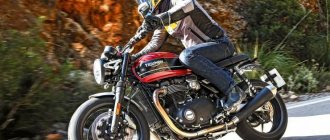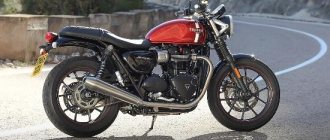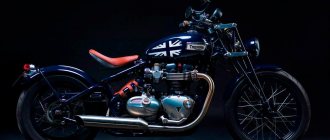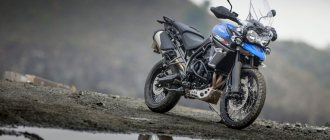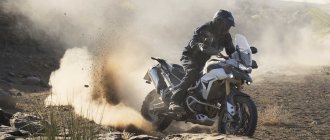City motorcycle Triumph Speed Twin 2022. Test
In the lineups of most brands there are almost always a couple of retro-styled motorcycles. But Triumph has no competition here: the number of their modern classics significantly exceeds the number of other models produced by the company from Hinckley.
Kawasaki W650 (1999–2008, RUR 190,000–300,000)
You can poke your nose at the Kawasaki W650 as much as you like for imitating the English school. This is a long-standing matter. The 650 has a rich history dating back to the 1960s. And even then the motorcycle was moderately original and self-sufficient. Be that as it may, in the modern table of ranks, the W650, despite the presence of a more advanced fellow W800, is firmly among the most desirable weekend classics and is considered one of the most “correct” donors for a café racing-scrambler project.
Engine
The basis is a structurally primitive and therefore very strong two-cylinder in-line carburetor engine with air cooling and timing drive via bevel gears (as on “antique” Ducati). With a working volume of 676 cm3, the in-line twin at its peak at 7000 rpm produces essentially a quite decent 50 hp. With. In addition to the electric starter, there is a kickstarter.
The engine is noticeably vibration-loaded and is not prone to overheating and oil loss. Moreover, a specific power unit will withstand even careless, untimely maintenance and driving on fuel of poor quality. The main thing is to regularly service carburetors! At high mileage, it may be necessary to replace the clutch discs. Nowadays, even among the twisted and twisted second-hand motorcycles, it is very difficult to find a copy with criminal engine problems. Long live the resource, dictated by the simplicity of the design and the low degree of forcing!
Transmission
The five-speed gearbox and clutch included in the W650 are strong and trouble-free units, but with specific controls. The gearbox is tough and capricious. Many W650 models experience excessively hard clutch release (an age-related disease). You literally have to coax the gears by powerfully stomping on the gearbox foot. Inclusions are not always accurate and timely.
Frame and body kit
The frame is a heavy half-duplex with a top part made of a rectangular pipe. The lower section is detachable. The rear subframe is made of a non-removable duplex element with a large number of amplifiers. Due to the fact that the engine protrudes greatly in width beyond its seats, it is difficult to damage the frame in a fall. If only in a frontal impact. The complete body kit is made of durable metal parts. Therefore, as a result of a moderate slip, the motorcycle will most likely be able to continue moving under its own power. In addition, metal parts can be adjusted and modernized to suit any taste and color.
Brakes
Brakes are not the Kawasaki W650's strong point. If the weak efficiency of the front disc brake can somehow be understood and even slightly corrected, then nothing can be done with the rear drum brake. At speeds up to 130–140 km/h, with thoughtful piloting, the deceleration dynamics are still sufficient. Everything after that is a lottery. The manufacturer did not provide an anti-lock braking system at that time.
Pendants
The suspensions, as befits a middle-aged classic, are as simple as possible (telescope, pendulum, pair of shock absorbers). The only adjustment is the shock absorber spring preload. By the nature of the factory settings, the chassis is focused on comfort and softness. The motorcycle literally floats above the road, lulling the crew and putting them in a contemplative mood. The W650 is a pleasure to drive on flat roads!
Comfort
The Kawasaki W650's rider is enveloped in comfort - a straight-backed, relaxed-arms riding position, well-designed controls and a soft seat cushion. With intros like these, every trip is fun and centered around piloting. The W650 is interesting in the city and beyond. Among the inconveniences, it is worth noting the weak standard head light, as well as the absence of a fuel gauge and a low fuel level lamp. Interestingly, due to the general fan factor, the Kawasaki W650 is highly valued even in prim England, which, it would seem, should only campaign for Triumph.
Kawasaki W650 is one of the record holders in terms of cost of ownership and availability of tuning. Parts and consumables are almost always available, and pricing is reasonable. There are a great many parts for modernization. With a couple of swings of a wrench, a motorcycle can be changed beyond recognition.
Modifications
The Kawasaki W650 was produced from 1999 to 2008 without significant changes. The model was mainly aimed at the Japanese and European markets. Test sales in America lasted only five years (1999–2004). In parallel with the “650”, a 400 cc version was produced on the Japanese market, differing from its larger cubic capacity brother only in the displacement of the cylinders. In 2008, the model became obsolete and was replaced by the more progressive classic Kawasaki W800 (injector, ABS, increased displacement, no kickstarter).
Triumph Speed Twin 2022
Now the new Speed Twin 2022 is on the list of classics. Has it become redundant or, on the contrary, has it become part of the lineup of one of the oldest motorcycle brands? I had a great opportunity to find out.
The original Triumph Speed Twin was named after the unusual (for those years) inline-two, created around 1938 by Edward Turner. Today's motorcycle, proudly bearing this name, is much closer to its contemporaries than the one of that time. You could call it a Street Twin on steroids, or a Bonneville with the characteristics of a Thruxton, minus the café features. I must admit, at first I treated it as a “spherical Triumph in a vacuum” - just another classic with an average engine and an intermediate design, similar to several models at once. But. British appearance can often be deceptively ordinary, and under the guise of a “typical” Briton hide fighters and writers, musicians and politicians... And under the classic appearance of the Speed Twin, I somewhat unexpectedly discovered a very modern roadster.
Engine
At the heart of the Triumph Speed Twin is a high-performance version of Bonneville's 1200cc High Power inline-twin engine - tuned identically to the Thruxton engine and featuring the same compression ratio (11:1). But the new model is not just a Thruxton in a new guise. A new lower-inertia crankshaft and higher-compression head, plus a magnesium alloy head cover, a new clutch and “weight-optimized” engine covers (that is, simply made lighter) are some of the changes that make the engine just 2 times faster. .5 kg lighter.
Triumph Speed Twin 2019
Power remains the same as the Thruxton R - 96 horsepower and 112 Nm, but the character of the engine has changed. The torque curve is a work of modern technical genius. Peak thrust is achieved at 4950 rpm, but 90% of the torque is available from 2500 rpm. Stock traction control can be switched off if desired, and three riding modes—Sport, Road and Rain—allow you to further customize the engine's character to suit your own taste and riding conditions. The model also received an easy-squeeze clutch and a six-speed gearbox, and the first maintenance is carried out at around 16,000 km!
Chassis and suspension
The Triumph Speed Twin has a dry weight of 196kg - 10kg less than the Thruxton and 7kg less than the Thruxton R. This is achieved thanks to new components such as cast aluminum wheels, aluminum frame elements, an aluminum swingarm and a lightweight battery. The chassis itself is an adapted version of the Thruxton with updated geometry. Triumph stretched it out, and, coupled with an extended wheelbase, the device received an increased steering angle, making the trail a couple of millimeters longer.
Both suspensions are equipped with elements from KYB - a non-adjustable conventional fork with a diameter of 41 mm and two rear shock absorbers with adjustable spring preload. Probably, the creators had a goal of reducing the price of the motorcycle, because other reasons for installing a basic suspension are somehow not obvious.
However, I was assured that the stock suspension perfectly copes with its tasks, and most consumers do not change the settings even on adjustable suspensions (which, by the way, is true). And when I asked whether we should hope for a Speed Twin R with an advanced suspension, company representatives declined to answer (which, quite likely, means “yes” in marketing parlance).
Brake system Triumph Speed Twin 2019
The Triumph Speed Twin braking system, consisting of two front four-piston Brembos and a single two-piston rear Nissin, is equipped with stock ABS. The wheels measure 17x3.5 at the front and 17x5.0 at the rear and are shod with aggressive Pirelli Diablo Rosso 3. Defiantly modern tires for such a classic motorcycle, but perfectly suited to the character of the Speed Twin - a modern powerful motorcycle in a classic image. It definitely shares its roots with the handsome Bonneville T120 - but looks more powerful and aggressive. Both bikes share the same 14.5-litre fuel tank, but the Speed Twin's is mounted at a slightly different angle, giving it a more rugged appearance.
Design elements
Design elements such as a dual-glass instrument panel with dial gauges complemented by LCD displays, a stylish fuel cap and dual upswept exhaust add old-school charm. Modern components create a bright and striking contrast with them - alloy wheels, diode running lights in the headlight and a thin diode tail light surrounded by the same elegant turn signals.
All this together looks damn cool - and this is not due to the professionalism of the photographer whose photographs are shown in the article. When interacting with the motorcycle in person, small but well-thought-out details become noticeable, not only beautiful, but also well-made. Short aluminum fenders, mirrors at the ends of the steering wheel, cutouts on the side panels and throttle bodies are stock equipment, and not sophisticated tuning from a catalog of expensive accessories. But yes, there is a tuning catalog for it too - brushed Vance & Hines mufflers, alternative seat options and other nice styling nuances. All elements look and feel solid, there is very little plastic, and despite the fact that the modern Triumph Speed Twin engine is liquid cooled, there is very little visible pipes (and wires). The only criticism about its appearance concerns the tail, in the area of the fender and taillight. It looks like a hasty, last-minute project.
The Speed Twin is available in three paint finishes: Jet Black, Silver Ice and Korosi Red. The silver and red versions were shown during the interview and both looked great. It’s interesting that the graphite line framing the black areas was made by hand. But the white stripe and the Triumph logo are just stickers under a layer of transparent film.
Triumph Bonneville T100 (2013 – present, RUB 280,000–550,000)
The Bonneville (named after a salt lake located in the US state of Utah) is an absolute legend in the world of classic motorcycles. Few people have such a rich past. Entire generations of motorcyclists grew up riding Bonnie. However, authenticity in the present is complicated. Regular upgrades make the model more technologically advanced and more advanced, to the detriment of that very “lamp-like quality” for which we value the classics.
Engine
The history of the incredibly beautiful parallel twin dates back to 1959, when the first Bonneville T120 went into mass production. A lot of water and fuel have flowed since then. The current generation of “Bonnie T100” does not waste time on trifles. Before us is a power unit of a similar layout, but with a “wet” sump, electronic fuel injection and water cooling. With a working volume of 900 cm3, the engine produces 54 liters. With. at 5900 rpm and 80 Nm at 3230 rpm.
The engine is famous for its reliability and unpretentiousness. Digests almost any fuel, is not prone to overheating and oil consumption. Due to the characteristics of dirt protection and the temperature regime of the engine, the exhaust pipes first turn blue very quickly, and then during operation they become overgrown with a dense crust of bitumen, soot and dirt. Some copies have floating electrical problems (remote controls, lights, control lamps).
There are some difficulties with large fasteners. In the climate of our vast homeland, in places it rusts literally before our eyes, which leads to difficulties in repair and broken threads.
Transmission
An important bonus that the owner of a Triumph Bonneville T100 gets is a precision-operating gearbox. Something similar can be found on Honda motorcycles. Gear shifts smoothly and easily, there are no false neutrals. There are difficulties with the clutch release mechanism. The lever is too tight even on new motorcycles. The need for the sixth stage is mostly far-fetched. The highest fifth stage essentially acts as a reasonable limiter. This motorcycle is not for racing!
Frame and body kit
The frame of the modern Triumph Bonneville T100 corresponds in absentia to the classical canons. The lower one-piece duplex section is visible from afar. However, upon closer examination, the steel structure turns out to be very complex and, moreover, not too rigid. The circuit is partially closed to the motor and is replete with various brackets. The upper part is made of a spinal pipe of almost square cross-section. Thanks to a large number of reinforcements, the steering column is one of the most massive in its class. The body kit is replete with small details and ubiquitous chrome. Some parts, despite their apparent monumentality, are made of plastic.
Brakes
Despite all the progressiveness, the braking system is of a purely formal nature, as if hinting that the Bonneville should not exceed speed limits. The same type of two-piston calipers on the front and rear wheels do not have high performance; they are afraid of moisture on the discs and overheating. We'll have to come to terms with it. Any modification will instantly damage the aesthetics of the motorcycle. Partially saved by the presence of an anti-lock braking system.
Pendants
The Bonneville's suspension components couldn't be simpler. A non-adjustable telescopic fork with protective corrugations and a pendulum rear suspension with two shock absorbers with adjustable spring preload are an absolutely standard set for a classic. In the case of the Bonneville T100, parasitic swaying and problems with directional stability occur at speeds well over 120 km/h, which is quite normal.
Comfort
Charisma, a wide ergonomic steering wheel, a soft flat seat and style in every detail - what more do fans of the classics need? In fact, the Bonneville T100 is a classically comfortable motorcycle. The driver can easily travel around all the bars in the area in an evening. Including the passenger. And the next day, throwing on side bags and a windshield from the accessories catalog, you can easily go on a short trip. There are a couple of nuances. In slushy weather or rain, the pants of the person in front are guaranteed to be dirty up to the knee. These are the features of aerodynamics. The original front fender does not remove dirt very well. Some owners note inconveniences associated with the location of the buttons on the steering consoles.
Modifications
The 2022 Triumph Bonneville T100 replaces the previous model with a 360-degree 865cc DOHC air-oil-cooled engine. Key innovations for 2022: new 270-degree powertrain, ABS braking system, stability control, electronic throttle, immobilizer, LED brake light, USB power output, new instrument panel. In parallel with the basic version, the T100 Black version is produced. It is distinguished by the abandonment of chrome in favor of an exclusively black exterior design.
Triumph
British sportbikes are not such frequent guests of the Bike Post due to their small number.
Let's take a closer look at the Daytona 675. Triumph decided to improve their sports bike a little, and they did it very well. Although the power hasn't increased, the Daytona arguably has the best chassis in the middleweight sportbike class. After undergoing a series of upgrades in 2009 to improve power and handling, the engine remains the same 675cc liquid-cooled engine for 2010. Power 124 hp power is achieved at 12,600 rpm, and peak torque of 72 Nm at 11,700 rpm. The figures are very good, considering that the bike with all fluids weighs 185 kg.
The front and rear suspension (Kayaba 41mm inverted forks and Kayaba monoshock) are fully adjustable in a wonderful way, giving the rider the ability to adjust the suspension compression for low or high speed.
In terms of braking performance, the 2010 Triumph Daytona has monobloc calipers and a radial master cylinder design working with 308mm discs. There's also a 220mm disc brake at the rear with a single-piston caliper.
Despite the fact that the motorcycle is equipped with a three-cylinder engine instead of four, like all mid-sized sportbikes, especially Japanese ones, the Daytona 675 can compete without any problems.
Technical characteristics of Triumph Daytona 675 2010:
• Type: In-line, three-cylinder • Displacement: 675 cc • Bore x Stroke: 74 x 52.3 mm • Compression ratio: 12.65:1 • Fuel system: Multiport sequential electronic fuel injection system • Final drive: chain • Clutch: oil bath multi-plate clutch • Gearbox: 6 speeds • Maximum power: 124 hp. at 12600 rpm • Maximum torque: 72 Nm at 11700 rpm • Frame: Aluminum • Swingarm: Aluminum alloy, adjustable pivot point • Front wheel: Aluminum alloy, 5-spoke, 17 x 3.5 • Rear wheel: Aluminum alloy , 5 - spokes, 17 x 5.5 • Front tire: 120/70 ZR 17 • Rear tire: 180/55 ZR 17 • Front suspension: Kayaba inverted fork 41 mm • Rear suspension: Kayaba monoshock / 130 mm travel • Front brakes: Pair, 308 mm discs, Nissin monoblock calipers with 4 pistons • Rear brakes: 220 mm disc, Nissin caliper with 1 piston • Length: 2022 m • Width: 708 mm • Height: 1105 mm • Seat height: 830 mm • Wheelset base: 1414 mm • Tilt/Trail: 23.9 */ 89.1 mm • Wet weight: 185 kg • Fuel tank capacity: 17.4 l
Triumph Daytona 675 video
Tire selection
The Japanese Kawasaki W800 is an even more English motorcycle in its essence than the truly English Triumph, which has modern technology wrapped in a retro shell. This can be seen in the wheel sizes: where the W800 has the old-style 19” in front and 18” in the rear, the T100 has an inch smaller, which narrows the choice of classic tires, but expands the choice of modern tires.
For Triumph, finding a front wheel may be difficult, and you should start your search from the front, and then select the rear for it, and it is not a fact that the front and rear will be the same model. Even at the factory for some time they installed Metzeler Lazertec forward and ME-2 backward. If you don’t bother with the design, you can find Michelin Pilot Active, Pirelli SportDemon, ContiRoadAttack2. If you want the appearance to correspond to the spirit of the turn of the 60-70s of the last century, then install Metzeler Lazertec or a standard installation - Pirelli Phantom. The front, like on the original BMW Funduro 650, and the rear from the “Goose-800” allow you to choose slightly off-road tires of the 50/50 class to externally turn the classic into a scrambler. But a real scrambler has a 19” front wheel for a reason – it has a much wider choice of designs.
To all of the above for Kawasaki, you can add chic Shinko E270 Super Classic wheels in sizes 4.00-19 forward and 4.50-18 rear, and you can find them either in regular black or with a wide white sidewall. In style and design it will be from the mid-50s of the twentieth century, but at the same time with modern grip properties. It looks pretentious and holds up with dignity. It will also be much easier with off-road tires - everyone makes these in standard sizes on enduro, and you can choose from asphalt-universal ones to really off-road ones with cubic blocks arranged in rows. There are many offers from Mitas, Continental, Kenda.
www.motorezina.ru is the oldest online store for motor tires in RuNet..
The wisdom of snowmobiling > December 21, 2022 14:13 Mikhail Pimus

